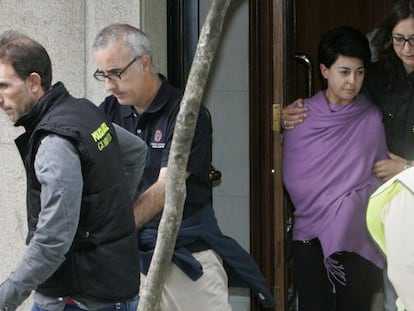Mystery surrounds contamination of evidence in Asunta investigation
Semen found on youngster’s clothing was traced to a suspected rapist in Madrid

Nobody among the professionals and experts involved in the investigation into the death of 12-year-old Asunta Basterra in Galicia in September has admitted responsibility for a monumental error: contaminating a vital piece of evidence — Asunta’s shirt — with semen pertaining to another case. There has been no official explanation as to how the chain of evidence was contaminated by the substance, which had been traced to a suspect in a sexual assault investigation in Madrid.
The misleading clue led the investigating judge and the Civil Guard on a wild goose chase and made an already horrific case even more sordid. The body of Asunta was discovered on September 22 in woodland near a family-owned property on the outskirts of Santiago de Compostela. Her adoptive parents, Rosario Porto and Alfonso Basterra, are in preventive custody and accused of drugging and asphyxiating their daughter in what investigators believe may have been a botched attempt to stage a kidnapping.
Two weeks ago, the DNA department of the Civil Guard’s forensic criminology lab in Madrid issued a statement to the A Coruña court handling the case and Judge Antonio Vázquez Taín flatly denying that the contamination had taken place in its installations. However, sources close to the case have repeatedly confirmed to this newspaper that this is precisely what occurred.
The autopsy conducted confirmed that Asunta had not been sexually assaulted in any way
The same sources, angered by doubts over the professionalism with which evidence in the Asunta case was collated and transferred to Madrid, maintain that it did not happen in Galicia. They state that it was minutely proven by telephone records that the suspect to whom the DNA belongs was not in Galicia on the weekend of her death, and was not connected to Porto and Basterra in any way.
Furthermore, on the forest trail where Asunta’s body was found, investigators found no prophylactics, soiled tissues or traces of sperm. The autopsy conducted confirmed that Asunta had not been sexually assaulted in any way.
The Civil Guard says the suspect in the Madrid assault inquiry has prior arrests, is a young man of Colombian descent and has lived in Spain for many years. A resident of Madrid, he was arrested in 2011 after a street brawl and is also on the Civil Guard’s records as a suspected rapist.
In lifting the judicial secrecy order on the Asunta case, Judge Taín confirmed this suspect had been among three men questioned in the A Coruña court as potential accomplices in the death of Asunta. The magistrate said this week he was satisfied that there was no third party involved in the case and that Rosario and Basterra remain the only suspects. They are expected to face a jury trial when the judge’s inquiry is complete.
The appearance of the misleading evidence in the middle of the investigation caused such a level of caution that the Galicia regional High Court took the extreme step of stating that the nature of the substance found on Asunta’s clothing had not been determined. An official spokesman told the media that he could not elaborate beyond speaking of a “fluid” or “liquid” because the forensic technicians had not identified its composition.
Tu suscripción se está usando en otro dispositivo
¿Quieres añadir otro usuario a tu suscripción?
Si continúas leyendo en este dispositivo, no se podrá leer en el otro.
FlechaTu suscripción se está usando en otro dispositivo y solo puedes acceder a EL PAÍS desde un dispositivo a la vez.
Si quieres compartir tu cuenta, cambia tu suscripción a la modalidad Premium, así podrás añadir otro usuario. Cada uno accederá con su propia cuenta de email, lo que os permitirá personalizar vuestra experiencia en EL PAÍS.
¿Tienes una suscripción de empresa? Accede aquí para contratar más cuentas.
En el caso de no saber quién está usando tu cuenta, te recomendamos cambiar tu contraseña aquí.
Si decides continuar compartiendo tu cuenta, este mensaje se mostrará en tu dispositivo y en el de la otra persona que está usando tu cuenta de forma indefinida, afectando a tu experiencia de lectura. Puedes consultar aquí los términos y condiciones de la suscripción digital.









































